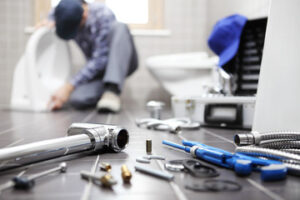Plumber install and connect pipes, fixtures, and appliances like sinks, toilets, and water heaters. They also follow blueprints and building codes to ensure that installations meet standards.

They can work in a variety of environments, both indoors and outdoors. They often work in tight spaces and have to be physically strong. They are also on call 24/7 to deal with plumbing emergencies.
Plumbing is a skilled trade with excellent job security and substantial financial rewards. It is also a highly flexible career choice, with many paths to licensure and certification that allow you to tailor your training to fit your personal goals. In addition, plumbing offers a high salary above the median wage in the United States and a great opportunity for advancement.
One of the most significant advantages of this profession is that it doesn’t require a college degree, which can save you thousands in tuition fees. Instead, you can learn the trade on the job or enroll in a vocational school program, which costs significantly less than a four-year college. In some cases, you can even participate in a paid apprenticeship, which will enable you to earn while learning the trade.
Plumbers are in high demand, as they are needed to maintain the water supply and sewage systems in homes, businesses, hospitals, and public works. Whether it’s a leaky faucet or an emergency sewer backup, plumbers are always in demand, and they can count on a steady stream of work. In fact, the job outlook for this occupation is excellent, and it will continue to grow in the coming years.
The skills required for this profession include critical thinking, verbal communication, and physical strength. In addition, plumbers must be able to operate diagnostic equipment to pinpoint problems quickly and accurately. They must also be able to communicate with customers in a clear and relaxed manner to explain their findings and recommend solutions. Moreover, they must have the ability to work in tight spaces and lift heavy equipment. This type of occupation is perfect for people who enjoy working with their hands and are good at problem-solving.
Flexibility
A plumber works on pipes and fittings that transport water, waste, and gases. They troubleshoot dysfunctional pipe systems and repair or replace worn parts. They also cut holes in floors, walls and ceilings to install or replace pipes. This job requires a lot of physical labor, but it’s a great fit for people with good manual dexterity and an interest in working with their hands.
Many plumbers earn their skills by doing an apprenticeship, which combines classroom instruction with paid on-the-job training. Apprenticeship programs typically last for four to five years and cover all aspects of the trade, from local codes and regulations to blueprint reading. After they complete their apprenticeships, most states require that plumbers obtain a license to work independently.
Depending on the type of plumbing work they do, plumbers may also need to install and connect appliances and fixtures such as sinks, toilets, tubs, and showers. They may also need to interpret building plans and specifications and ensure that all plumbing work meets local and national safety standards. Plumbers may also need to be able to work on ladders or in tight spaces.
A successful plumber is able to communicate effectively with a diverse range of people, including assistants, managers, customers, and other team members. They must be able to express their thoughts clearly and explain complex issues in simple terms. They also need to be able to handle stressful situations. Some plumbers are self-employed, which gives them more flexibility in their schedules and allows them to set their own hours. However, they must still follow strict safety protocols when working with hazardous materials or in confined spaces. Using field dispatch software like ServiceTitan helps plumbers keep track of their time and avoid costly mistakes by calculating traffic delays and rescheduling jobs as needed.
Reliability
A plumber is a tradesperson who installs and repairs systems used for water, sewage and drainage in homes and businesses. These systems are critical to the health and comfort of occupants, providing them with access to clean drinking water and effective waste disposal. Plumbers are skilled professionals who use a variety of tools and techniques to carry out their work. They often operate in confined spaces, such as crawl spaces and basements.
The job of a plumber requires extensive training and experience. In addition to technical knowledge, plumbers must be familiar with building codes and regulations. They must also be able to interpret blueprints and plans in order to ensure that the plumbing system is installed according to specifications. They may also need to perform tests on water pressure and other factors that could affect the performance of the system.
Plumbers work directly with the public and must be able to communicate effectively with customers. They may need to explain their services and provide cost estimates for their work. They may also need to be able to work under tight deadlines, particularly in emergency situations.
Reliability is the probability of a product or service performing its required function without failure. It is an important metric for any business, but it’s not always easy to measure. There are many different definitions of reliability, ranging from general and layman to exact and scientific. The most common definitions of reliability focus on the time before a product fails, and ignore the effects of operating environment. For example, a server that is in constant use will have a lower reliability than one that is rarely used. However, the more precise definitions of reliability consider both the time before failure and the operating environment.
Earning potential
A plumber’s earning potential depends on a variety of factors, including their level of experience and qualifications. Many plumbers receive their training through a vocational school or apprenticeship program, which provides them with the skills and knowledge necessary for the job. These programs typically last four to five years and include classroom instruction and paid on-the-job training. The training and certifications that a plumber obtains during these years will often lead to higher income potential.
Having exceptional customer service skills can also help a plumber increase their earning potential. This is because customers are more likely to recommend their services to others and return for additional plumbing needs. In addition, it is important to stay up to date on new technologies and tools. This will improve a plumber’s efficiency and allow them to complete more jobs in a shorter period of time.
Additionally, the earning potential of a plumber can be increased by pursuing advanced certifications. These skills can help them meet increasing demand for sustainable and energy-efficient plumbing solutions. In some cases, these advanced certifications can even lead to higher salaries.
Other factors that can influence a plumber’s earnings potential include their location and the type of work they perform. For example, plumbers who work in industrial settings often earn more than those working in residential settings. These jobs require specialized knowledge of large pipe networks for industrial water systems, gas lines, and other high-pressure systems. Additionally, plumbing contractors who offer 24/7 emergency services can often charge higher rates than those who do not. Finally, union members can also increase a plumber’s earning potential. This is because unions usually negotiate with employers for standardized wages and comprehensive benefits packages.

